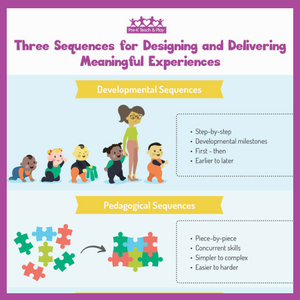 Have you ever wondered what comes before “being able play with friends at recess” or what skills children need to pass the “3rd grade reading guarantee”? In this episode, I explore how we can better understand how children…get from here to there…in terms of early development and learning.
Have you ever wondered what comes before “being able play with friends at recess” or what skills children need to pass the “3rd grade reading guarantee”? In this episode, I explore how we can better understand how children…get from here to there…in terms of early development and learning.
Context for this Pre-K Teach & Play podcast episode
In our work around blended practices, Dr. Jennifer Grisham-Brown and I propose three types of sequences within the scope and sequence element of the curriculum framework. Scope refers to the breadth of what is taught in a pre-K classroom (i.e., content/developmental areas), and sequence refers to the order in which outcomes are taught.
There are three types of instructional sequences. First, skills can be taught in a developmental sequence, which is a generally agreed-on order in which children acquire skills, taking into account the fact that the children’s culture or the presence of a specific impairment may affect the sequence. Second, research has shown that some skills lay the foundation for children to learn other skills, resulting in teaching in pedagogical sequences. For example, rhyming is often taught as a foundational skill for learning early literacy skills. Finally, skills may be taught in a logical sequence, meaning that teachers select skills based on what makes the most sense to teach a child at a given point in time. For example, if a child does not have a functional way to express his or her wants and needs, then that skill might be taught before other skills.
Complete the form below to receive an infographic which depicts the three types of sequences: developmental, pedagogical, and logical.
This episode is for you if you’ve ever wondered…
- Is this something all children should be learning right now?
- What comes before or earlier in development?
- How do we scaffold and support a child who is struggling to make progress?
This episode is also for you if you are interested in learning how to use an authentic curriculum-based assessment, the Assessment, Evaluation, and Programming, System (AEPS), to help you tackle these complex questions.
As a side note, if you are interested in training or support around the AEPS, contact me. I’m a co-author and have been training on the tool since 1993.
And don’t worry if you aren’t an AEPS user, or if you live in a state where you are mandated to use a different assessment for planning and revising instruction. In this episode, I talk about how the AEPS is organized, and how using it as a reference, can help you better design and deliver meaningful learning experiences. And spoiler alert….you don’t have to score the AEPS to reap the benefits.
LISTEN NOW
Click here to download a transcript of Podcast #26, and complete the form below to receive an infographic which depicts the three types of sequences, developmental, pedagogical, and logical.